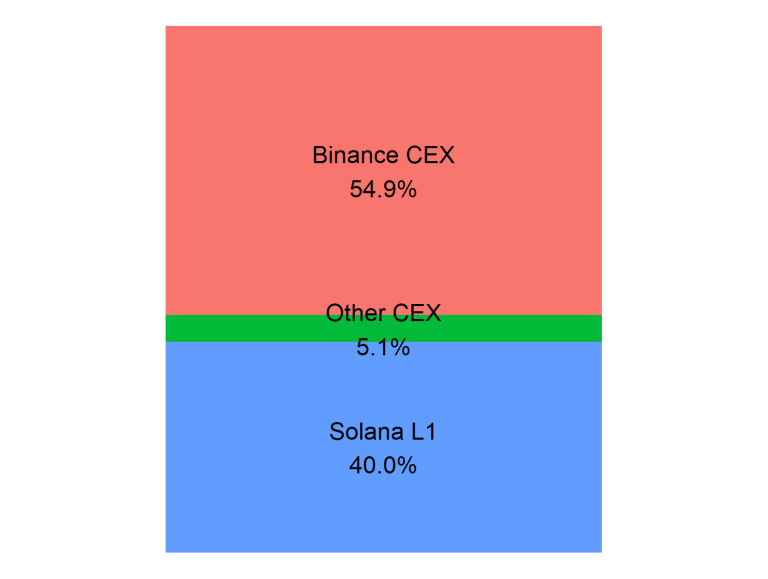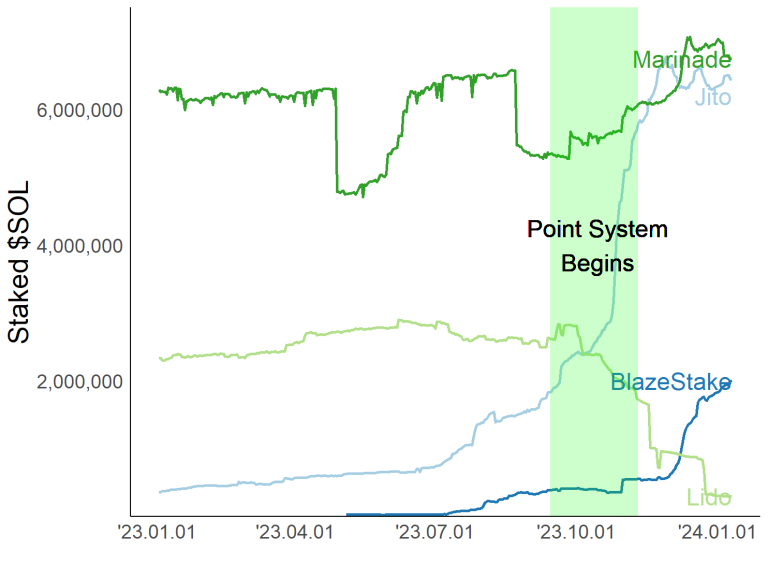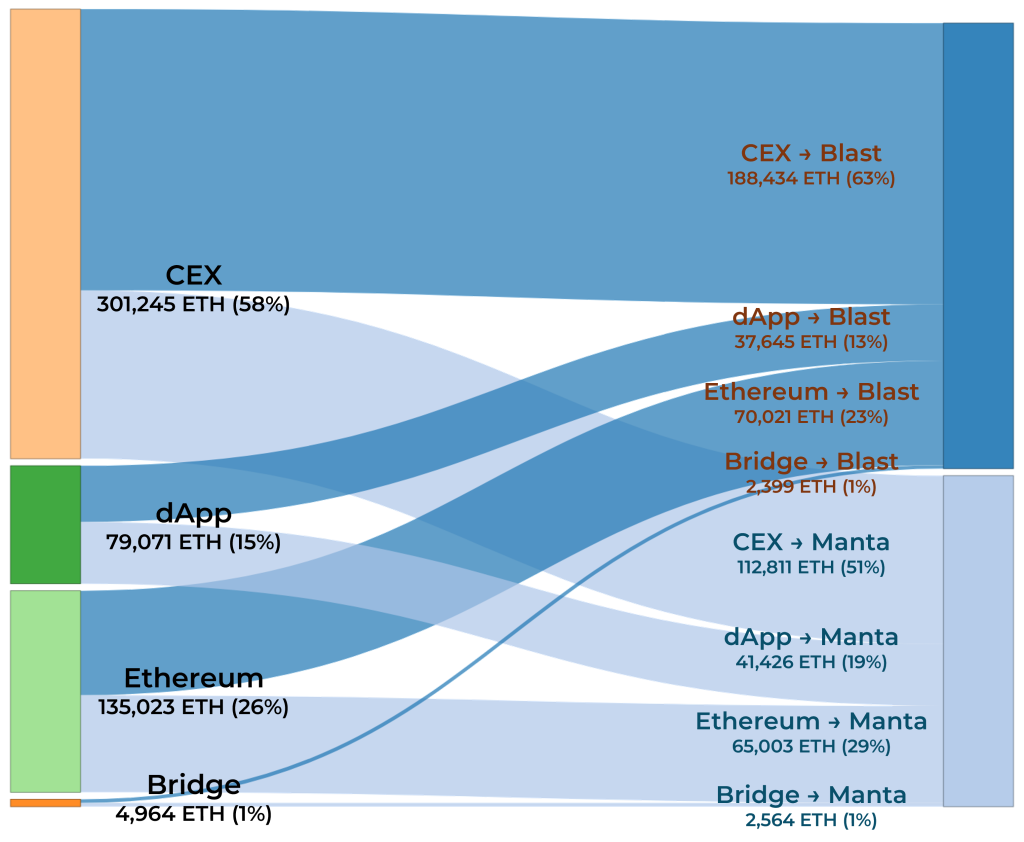Paradigm's Point-based Airdrops Are Not Predatory
Table of Contents
Index
Important Disclaimer
1. Introduction
Paradigm popularized the point-based airdrop games, from hereunder dubbed ‘Point System,’ as the effective GTM strategies to be deployed by numerous established projects, the topmost examples being Manta and Blast.
One possible criticism arising for the Point System is that it could potentially absorb users away from the peers with monetary rewards, and thus forces them to outbid in airdrops rather than focusing on the fundamentals.
The core question we are addressing in this paper would be: “Are the Point-based Airdrops overall predatory for the ecosystem or mutually beneficial?”
Considering each ecosystem as a closed system, we could directly track down the sources of the inflows to the ecosystems utilizing the Point System and measure the portion flowing internally (within the ‘closed system’) and externally.
We will define the methodologies first, then write about our findings from two closed systems: the Ethereum L2 ecosystem and the Solana L1 ecosystem.
Executive Summary
- – Majority (60%+) of ETH inflow into Manta/Blast originates from CEXes rather than other L2s
- – Similarly, 60%+ of SOL inflow into Jito during its Point campaign are also sourced from CEXes
- – Based on the findings, Point Systems incentivize funds that are sitting idle on the external territory to be moved for possible gains
- – Hence, Point Systems are mutually beneficial within the ecosystem
2. Data Specification
We collected all deposit transactions to the sample Point Systems, including Blast, Manta, and Jito, and for each deposit transaction identified deposit address as of 2024.01.05.
For each deposit address of the deposit transaction, we looked for all incoming transactions finalized within 200 blocks (or roughly 40 minutes) from the deposit transaction, and defined these incoming transactions as ‘fund origins.’ The block criteria was set for 200 blocks for the Ethereum blockchain and 6,500 blocks for the Solana blockchain.
Out of all the identified fund origins, we excluded all incoming transactions with transaction value of less than 10% of the deposit transaction value from the dataset to adjust for minuscule transfers for gas fees, faucets, or for other purposes.
Finally, we labeled the source addresses based on the public blockchain labeling databases.

Figure 1 – A Diagram of the Criteria
3. Result
As we are studying the exploitativeness of the Point Systems, we looked into the sources of the funds deposited into Manta and Blast to check whether they absorbed funds from L2s or from other sources.

Figure 2 – Sources of Funds Flow Into Blast L2 and Manta L2
For both Blast and Manta, $ETH deposits bridged from other L2s constitute 1% of the total deposits, and the majority came from CEXes.

Figure 3 – Percentage Breakdown on Sources of Funds Flow Into Jito
The resolution of the Solana data is slightly different from the Ethereum counterpart due to differences in data sizes.
A noteworthy parallel is that the percentage of funds sourced from CEXes are similar for all three samples: Blast (63%), Manta (51%), and Jito (60%). If we were to extrapolate further, we could also arrive at the conclusion that the addition of Jito absorbed mostly the idle SOL on the Solana L1, rather than other dApps.
Judging from the analysis, we put forth an assertion that the adoption of Point Airdrop system by protocols to drive in the scarce attention is not predatory within the closed system, but instead is mutually beneficial to peer projects as it absorbs funds from external sources, rather than from internal reallocation.

Figure 4 – TVL (in $SOL) Growth For LST Protocols on Solana
The changes in Staked $SOL of the LST protocols on Solana have been mostly positive throughout the entire Point System of Jito, the only loser being Lido, a non-native LST protocol.
Figure 3 also bolsters our thesis that the Point System is mutually beneficial – Jito’s exponential growth was attributable to CEX withdrawals rather than to outflows from Marinade or other LSTs.
Although judging from the drop in Lido, the Point System from a dApp to another dApp is not as innocuous as it is from an L2 to another L2, but still it is mostly beneficial.
4. Concluding Remarks
Although airdrops have been frequently criticized by various opinion leaders, they are by far the most effective attention grabbers in the Web3 field. The core problem was that whether these airdrops, or the Point Systems, simply redirected attention away from the existing protocols to the Point Systems, or it has created new attention flows from the outside world.
Our research shows that under the assumption that each ecosystem is a closed system, airdrops are actually mutually beneficial as it introduces newcomers to the ecosystem and aggravates the growth of the overall closed system instead of preying on existing peers.
Nonetheless, our paper still brings two caveats with it: One is that the flows from L2 to CEX to Ethereum L1 are still recognized as CEX deposits, even though the intentions behind such order flows would be to save on gas fees or to avoid security risks from bridges. The other caveat is that we have labeled CEXes as ‘external factors’ independent of L1 blockchains; even though assets on CEXes are still recorded on the blockchains.
We would like to conclude that the Point Systems are reciprocal not only to users but also to peer dApps or L2 projects as well.
